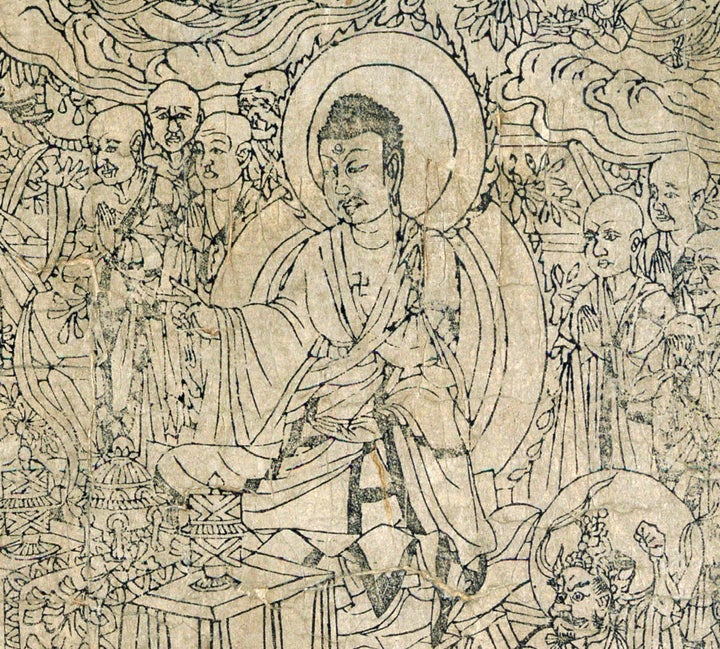
With a Buddha surrounded by flames and flanked by two brutish figures, the scene at the heart of the earliest-known drawing in a printed book might seem an unlikely source of spiritual comfort. Then again, you could say the same for the cross, Christianity's symbol of an excruciating death.
The illustration appears at the beginning of the Diamond Sutra of 868 A.D. The artwork and the book that contains it -- a key Buddhist teaching -- were discovered in 1900 inside a cave that had been cut into a cliff, then sealed for a thousand years on the fringes of China's Gobi Desert.
The woodblock-printed image, known as a frontispiece because it appears at the front of this sacred scroll, measures 28 centimeters wide and 23 centimeters tall (11 inches by 9 inches). When I was fortunate enough to see the printed image in the conservation department of the British Library, I was struck by how dense it is with symbolism. Dense, but not indecipherable.
Just as European art can be unpicked by a knowing eye, so can the Diamond Sutra frontispiece, and it reveals much about Buddhism in the days of the Silk Road.
In the West, we are so familiar with Christian symbols that sometimes we scarcely even realize we are making associations. We see an apple; we think of forbidden fruit. We see a fig leaf; we think of lost innocence.
Similarly, in the Diamond Sutra's frontispiece, the flames that encircle the Buddha symbolize his purity. Two angelic figures that float above him carry offerings of fruit and lotus blossoms, the latter itself a symbol for its ability to produce beauty amid mud.
Other elements in the artwork are prone to confuse, whether because they have dual meanings or, as with the two-fingered gesture of the Buddha's right hand, because meanings change across centuries and cultures. What is an "up yours" salute in some countries now was a peace sign in the American 1960s and a V for Victory sign for Winston Churchill in the 1940s. But in ninth-century China, the gesture was recognized as a symbol of the Buddha's wisdom.
In the lower left of the illustration, an elderly monk seems to cower before the Buddha and two fearsome deities. In fact, the monk's position is merely one of supplication. This bald, wrinkled monk would have been instantly recognizable to those who saw his image.
His name is Subhuti, and he was among the Buddha's greatest disciples. In his youth, Subhuti was said to have been foul-tempered, but the artwork suggests that the Buddha's message can help lead even the most cantankerous individual toward enlightenment.
Subhuti appears for another reason as well. The Diamond Sutra, one of Buddhism's most popular teachings, is said to recount a conversation between the Buddha and Subhuti in which the central message is that nothing is permanent. Or, as a poetic line in the sutra puts it, the reality we perceive is as insubstantial as "a bubble in a stream."
When it was produced, the frontispiece was useful for how it helped transmit this early story of Buddhism. Most of the world, in China and elsewhere, was illiterate. The frontispiece made the ideas of Buddhism accessible to the everyone who might see the artwork and absorb its messages, even if the written word was beyond them.
On this, Buddhism had no monopoly; the same can be said of Leonardo da Vinci's "Last Supper" or Michelangelo's "Creation of Adam" on the ceiling of the Sistine Chapel. Images have transcended the limits of language since prehistoric horses galloped across hand-painted caves in present-day Europe.
Part of what makes the frontispiece that adorns the Diamond Sutra of 868 A.D. so special is what it reveals about everyday life along the ancient Silk Road.
Monks, of course, help populate the image -- no surprise there. Monasteries in the East and West have long been the guardians of the world's faiths. But on the lower right-hand side stands a cluster of well-dressed but otherwise unextraordinary people that tells us something else.
Who are they?
They're sponsors, the powerful people of their community who financed the creation of the book and its opening illustration. They appear partly as a reminder of their wealth and influence. But there's another, more altruistic reason. The Diamond Sutra holds that spreading the message of Buddhism sews the seeds for a better life.
And for believers, from East or West, a thousand years ago or now, that's a comforting message, whether imparted through words or pictures.
